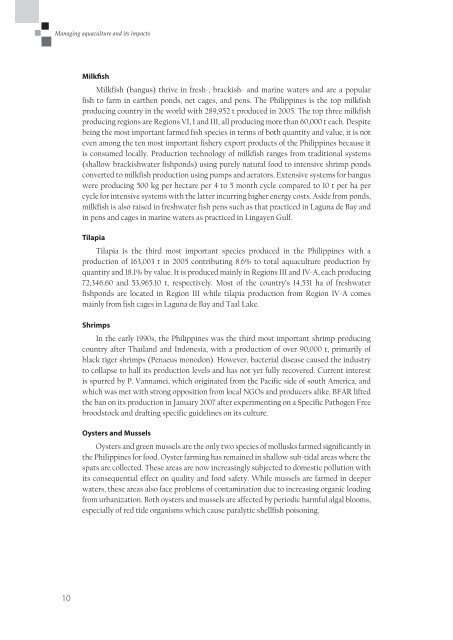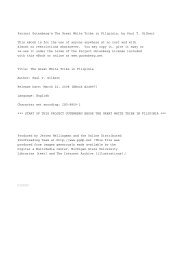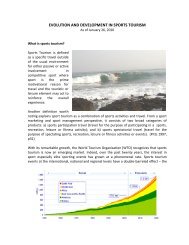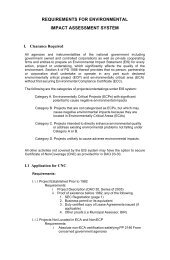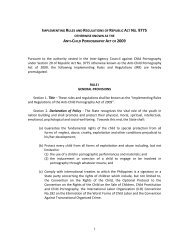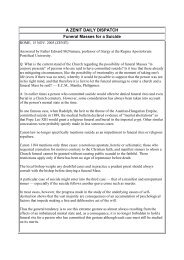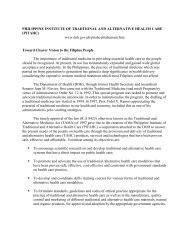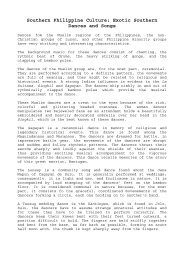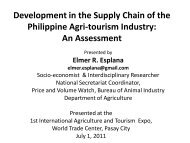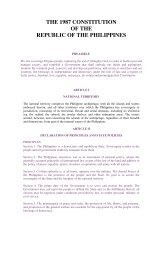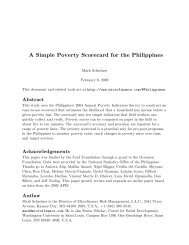Untitled - About the Philippines
Untitled - About the Philippines
Untitled - About the Philippines
Create successful ePaper yourself
Turn your PDF publications into a flip-book with our unique Google optimized e-Paper software.
Managing aquaculture and its impacts: a guidebook for local governments<br />
Milkfish<br />
Milkfish (bangus) thrive in fresh-, brackish- and marine waters and are a popular<br />
fish to farm in ear<strong>the</strong>n ponds, net cages, and pens. The <strong>Philippines</strong> is <strong>the</strong> top milkfish<br />
producing country in <strong>the</strong> world with 289,952 t produced in 2005. The top three milkfish<br />
producing regions are Regions VI, I and III, all producing more than 60,000 t each. Despite<br />
being <strong>the</strong> most important farmed fish species in terms of both quantity and value, it is not<br />
even among <strong>the</strong> ten most important fishery export products of <strong>the</strong> <strong>Philippines</strong> because it<br />
is consumed locally. Production technology of milkfish ranges from traditional systems<br />
(shallow brackishwater fishponds) using purely natural food to intensive shrimp ponds<br />
converted to milkfish production using pumps and aerators. Extensive systems for bangus<br />
were producing 500 kg per hectare per 4 to 5 month cycle compared to 10 t per ha per<br />
cycle for intensive systems with <strong>the</strong> latter incurring higher energy costs. Aside from ponds,<br />
milkfish is also raised in freshwater fish pens such as that practiced in Laguna de Bay and<br />
in pens and cages in marine waters as practiced in Lingayen Gulf.<br />
Tilapia<br />
Tilapia is <strong>the</strong> third most important species produced in <strong>the</strong> <strong>Philippines</strong> with a<br />
production of 163,003 t in 2005 contributing 8.6% to total aquaculture production by<br />
quantity and 18.1% by value. It is produced mainly in Regions III and IV-A, each producing<br />
72,346.60 and 53,965.10 t, respectively. Most of <strong>the</strong> country’s 14,531 ha of freshwater<br />
fishponds are located in Region III while tilapia production from Region IV-A comes<br />
mainly from fish cages in Laguna de Bay and Taal Lake.<br />
Shrimps<br />
In <strong>the</strong> early 1990s, <strong>the</strong> <strong>Philippines</strong> was <strong>the</strong> third most important shrimp producing<br />
country after Thailand and Indonesia, with a production of over 90,000 t, primarily of<br />
black tiger shrimps (Penaeus monodon). However, bacterial disease caused <strong>the</strong> industry<br />
to collapse to half its production levels and has not yet fully recovered. Current interest<br />
is spurred by P. Vannamei, which originated from <strong>the</strong> Pacific side of south America, and<br />
which was met with strong opposition from local NGOs and producers alike. BFAR lifted<br />
<strong>the</strong> ban on its production in January 2007 after experimenting on a Specific Pathogen Free<br />
broodstock and drafting specific guidelines on its culture.<br />
Oysters and Mussels<br />
Oysters and green mussels are <strong>the</strong> only two species of mollusks farmed significantly in<br />
<strong>the</strong> <strong>Philippines</strong> for food. Oyster farming has remained in shallow sub-tidal areas where <strong>the</strong><br />
spats are collected. These areas are now increasingly subjected to domestic pollution with<br />
its consequential effect on quality and food safety. While mussels are farmed in deeper<br />
waters, <strong>the</strong>se areas also face problems of contamination due to increasing organic loading<br />
from urbanization. Both oysters and mussels are affected by periodic harmful algal blooms,<br />
especially of red tide organisms which cause paralytic shellfish poisoning.<br />
10


